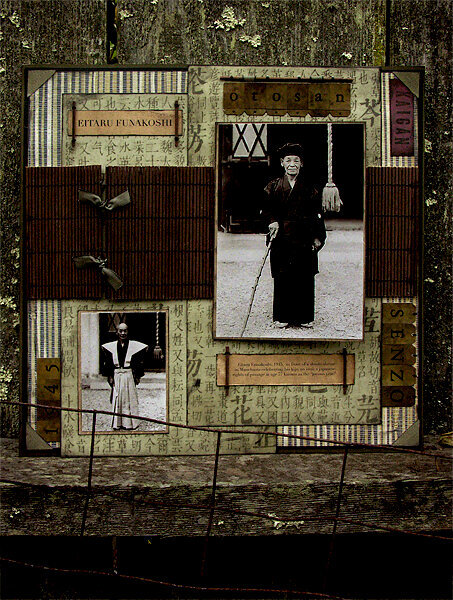Plus, a FREE Gift! | Details Here.


 Give a Cheer
Give a Cheer
"He loved his children, but very strict. If mad ... oooooh ... his
eyes! He didn't say anything. Silent. He was that strong and
powerful," explained Grace Sonoda, talking about her father, Eitaru Funakoshi.
Born in 1868, at the beginning of the Meiji Restoration, Eitaru
Funakoshi was raised in Kyushu Fukuoka, Japan. As an adult, he moved to Korea where he married a Japanese woman, (maiden name Saito) and opened a tea house.
The couple had no children, although Funakoshi raised his wife's orphaned niece (Tokie) and nephew (Masae) as his own. Eventually their relationship faltered and they divorced. He then moved to the small city of Kaigan, in Japanese-occupied Manchuria, where he married picture bride Iwa Nishioka of Kyushu Saga, Japan. She was a
childless divorcee as well.
The newlyweds were nearly 20 years apart in age but close at heart. When asked if they were happy, Grace exclaimed with a laugh, "I think so! My father kinda old, but they make for four kids already!"
Their first son, Shigeo, was born in 1919, followed two years later
by another son, Masayuki. On September 1, 1923, their only daughter, Chiyono (Grace), was born, followed by their last child, Shoji, four years afterward.
The family lived comfortably. Eitaru was a contractor and built the small city's many slaughterhouses. He also built the family's house in traditional Japanese style, complete with sliding shoji and fusuma doors, tatami mats, as well as the hand-crafted furniture inside.
The home was literally steeped in the arts. A master of Sado, or the Zen practice of the Japanese tea ceremony, Eitaru taught his wife and children the meditative ritual. As a Sensei, he also taught the nurses from the hospital where he once worked as a pharmacist.
He sung passionately, although Grace was less than enthusiastic about his voice.
"He would take me to the udon shop and sing with the owner. She played the shamisen. She did 'Bang! Bang! Bang!' on the shamisen and he did (singing) 'Oooou … Ouuuho … Ooouo … Uo … Ooouho.' I'm not interested … so I look for the sleep!" Grace said with the same exasperation she must of felt as a child.
As did his samurai forefathers, Eitaru mastered the art of weaponry, known for his skill as an archer. In these pictures, Eitaru posed stoically for his kiju no iwai in front of the Shinto shrine which bore a plaque dedicated to his unbeatable archery skills.
"He was number one," said Grace proudly.
And forever will he remain the number one man in Grace Sonoda's history.
Epilogue: Eitaru Funakoshi passed away in his Kaigan home at the age of 79 after a painful battle with stomach cancer.
"He was in so much pain but he never complain once," said Grace, who helped comfort her dying father.
His ashes lay in Kyushu Fukuoka, Japan.
Photo Caption: Eitaru Funakoshi, 1945, in front of a Shinto shrine in Manchuria celebrating his kiju no iwai - a Japanese rite of passage marking the age of 77, known as the "joyous year."
Note: Eitaru wore traditional samurai garb for the portraits. He is dressed in a silk kimono with the family mon (crest) embroidered on the sleeves. The walking stick was not used every day.He also wore a red hat made especially for the occasion.
Interviews conducted from 2003 to 2005 by Grace Sonoda's
granddaughter, Cindy Ellen Russell
Rusty Pickle Papers:
-Chinese Document
-Raffia
-Ryan Rendezvous
-Rustic Red
-Army Green/Desert Sand Cardstock
Rusty Pickle Embellishments:
-Large Undecorated Tags (diced)
-Alpha tags/Traditional Bark
-Pewter Two Tone Ribbon
-'Simple' Rubber Stamps
Other:
-Bazzill cardstock
-Threaded wood
-Colorbox ink
-Didot Font
No products have been added to this project.
Thanks for spreading positivity!
June 23, 2009
November 09, 2005
November 04, 2005
October 26, 2005
October 26, 2005
October 25, 2005
October 25, 2005
October 25, 2005
October 25, 2005
October 23, 2005
October 22, 2005
October 22, 2005
October 22, 2005
October 22, 2005
October 22, 2005
October 22, 2005
October 22, 2005
October 22, 2005
October 21, 2005